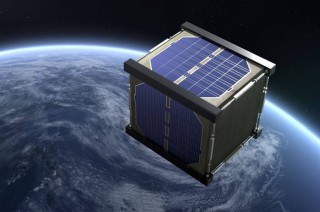Loading
Search
▼ Japan To Launch World’s First Wooden Satellite To Combat Space Pollution
- Category:Other
Japanese scientists have created one of the world’s most unusual spacecraft – a tiny satellite that is made of timber.
The LignoSat probe has been built of magnolia wood, which, in experiments carried out on the International Space Station (ISS), was found to be particularly stable and resistant to cracking. Now plans are being finalised for it to be launched on a US rocket this summer.
The timber satellite has been built by researchers at Kyoto University and the logging company Sumitomo Forestry in order to test the idea of using biodegradable materials such as wood to see if they can act as environmentally friendly alternatives to the metals from which all satellites are currently constructed.
“All the satellites which re-enter the Earth’s atmosphere burn and create tiny alumina particles, which will float in the upper atmosphere for many years,” Takao Doi, a Japanese astronaut and aerospace engineer with Kyoto University, warned recently. “Eventually, it will affect the environment of the Earth.”
To tackle the problem, Kyoto researchers set up a project to evaluate types of wood to determine how well they could withstand the rigours of space launch and lengthy flights in orbit round the Earth.
The first tests were carried out in laboratories that recreated conditions in space, and wood samples were found to have suffered no measurable changes in mass or signs of decomposition or damage.
“Wood’s ability to withstand these conditions astounded us,” said Koji Murata, head of the project.
After these tests, samples were sent to the ISS, where they were subjected to exposure trials for almost a year before being brought back to Earth. Again they showed little signs of damage, a phenomenon that Murata attributed to the fact that there is no oxygen in space which could cause wood to burn, and no living creatures to cause it to rot.
Several types of wood were tested, including Japanese cherry, with wood from magnolia trees proving to be the most robust. This has now been used to build Kyoto’s wooden satellite, which will contain a number of experiments that will determine how well the spacecraft performs in orbit, said Murata.
“One of the missions of the satellite is to measure the deformation of the wooden structure in space. Wood is durable and stable in one direction but may be prone to dimensional changes and cracking in the other direction,” he told the Observer.
Murata added that a final decision had still to be made on the launch vehicle, with choices now narrowed down to a flight this summer on an Orbital Sciences Cygnus supply ship to the ISS or a similar SpaceX Dragon mission slightly later in the year.
It is expected that the probe – which is the size of a coffee mug –will operate in space for at least six months before it is allowed to enter the upper atmosphere.
The LignoSat probe has been built of magnolia wood, which, in experiments carried out on the International Space Station (ISS), was found to be particularly stable and resistant to cracking. Now plans are being finalised for it to be launched on a US rocket this summer.
The timber satellite has been built by researchers at Kyoto University and the logging company Sumitomo Forestry in order to test the idea of using biodegradable materials such as wood to see if they can act as environmentally friendly alternatives to the metals from which all satellites are currently constructed.
“All the satellites which re-enter the Earth’s atmosphere burn and create tiny alumina particles, which will float in the upper atmosphere for many years,” Takao Doi, a Japanese astronaut and aerospace engineer with Kyoto University, warned recently. “Eventually, it will affect the environment of the Earth.”
To tackle the problem, Kyoto researchers set up a project to evaluate types of wood to determine how well they could withstand the rigours of space launch and lengthy flights in orbit round the Earth.
The first tests were carried out in laboratories that recreated conditions in space, and wood samples were found to have suffered no measurable changes in mass or signs of decomposition or damage.
“Wood’s ability to withstand these conditions astounded us,” said Koji Murata, head of the project.
After these tests, samples were sent to the ISS, where they were subjected to exposure trials for almost a year before being brought back to Earth. Again they showed little signs of damage, a phenomenon that Murata attributed to the fact that there is no oxygen in space which could cause wood to burn, and no living creatures to cause it to rot.
Several types of wood were tested, including Japanese cherry, with wood from magnolia trees proving to be the most robust. This has now been used to build Kyoto’s wooden satellite, which will contain a number of experiments that will determine how well the spacecraft performs in orbit, said Murata.
“One of the missions of the satellite is to measure the deformation of the wooden structure in space. Wood is durable and stable in one direction but may be prone to dimensional changes and cracking in the other direction,” he told the Observer.
Murata added that a final decision had still to be made on the launch vehicle, with choices now narrowed down to a flight this summer on an Orbital Sciences Cygnus supply ship to the ISS or a similar SpaceX Dragon mission slightly later in the year.
It is expected that the probe – which is the size of a coffee mug –will operate in space for at least six months before it is allowed to enter the upper atmosphere.
- February 19, 2024
- Comment (0)
- Trackback(0)


